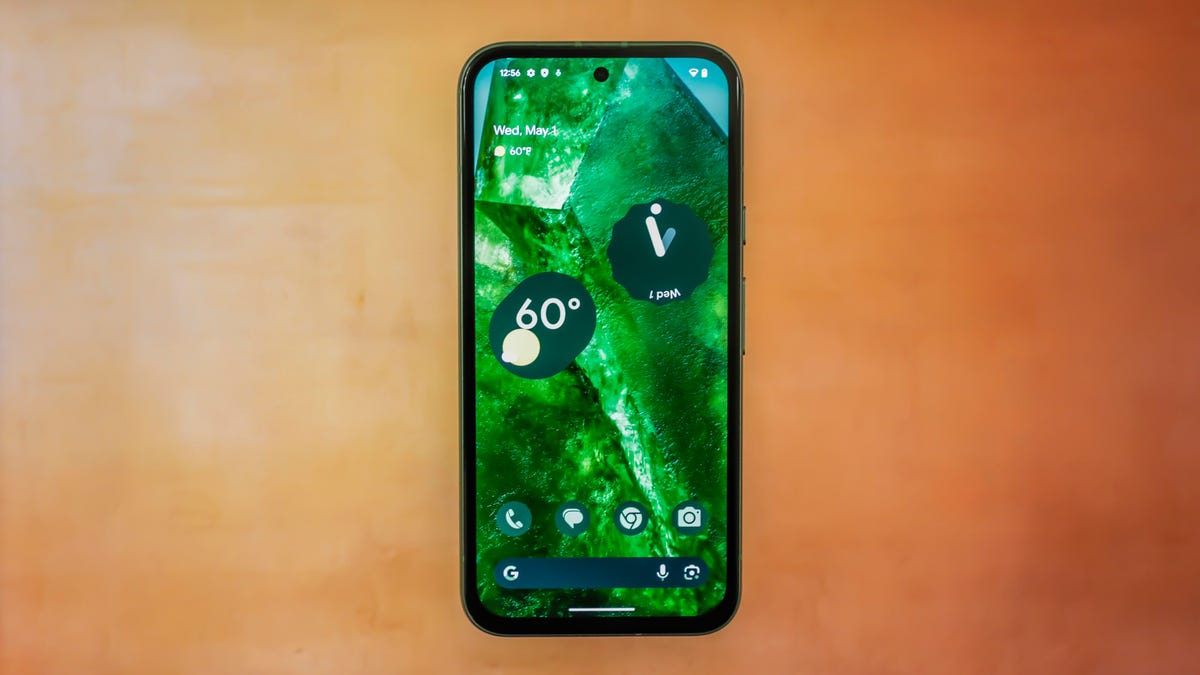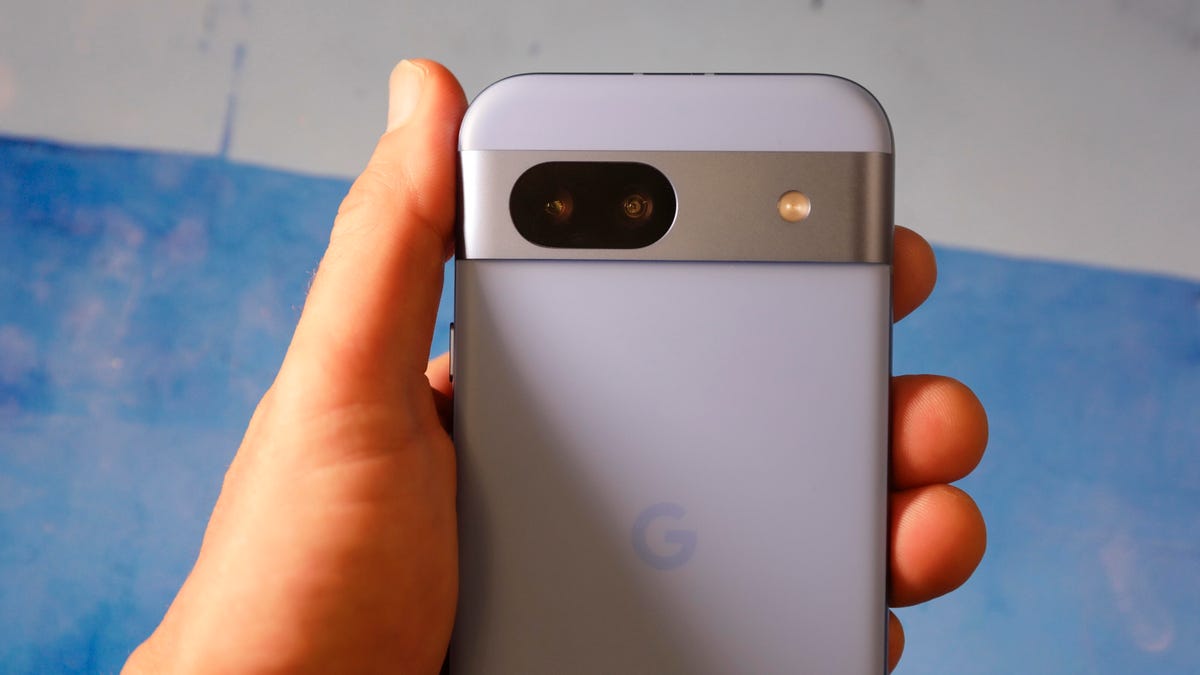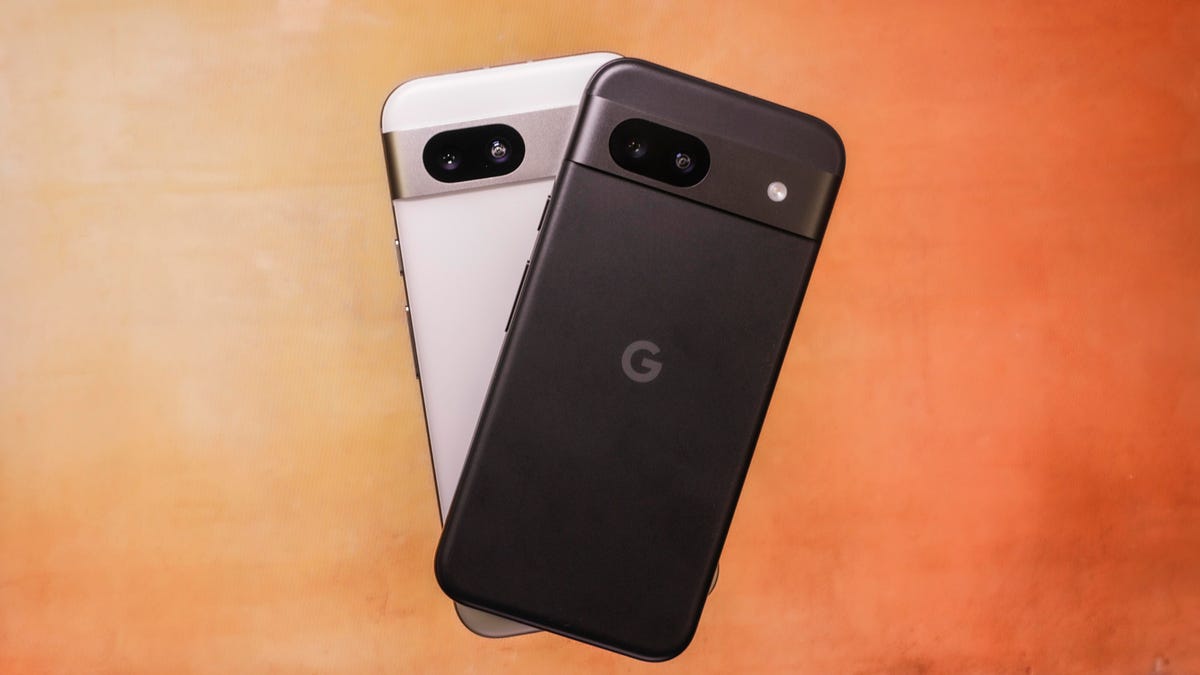Google has unveiled its Pixel 8A budget phone, which will sell for $500 starting May 14 — the same day the company’s I/O developers conference kicks off. How does this lower-priced device stack up against the flagship Pixel 8 (which starts at $700)?
Like previous Pixel A devices, this one shares a lot of commonalities with its pricier counterpart. That includes similar displays, battery life and processors. There are some slight variations between the cameras, and the Pixel 8A comes in a couple of different color options.
Here’s a closer look at how the specs on each device match up.
See also: Google’s Pixel 8A Arrives With a Bigger Dose of AI
Displays: Similar size, same brightness
The Pixel 8A’s display is about the same size as the standard Pixel 8’s. The former has a 6.1-inch Actua display, while the latter’s is 6.2 inches, both with a 20:9 aspect ratio. The two phones deliver up to 1,400 nits in HDR and up to 2,000 nits of peak brightness.
Both displays go up to 120Hz and include an always-on feature, which lets you see the time and any notifications on your lock screen, without waking up your phone.
The Pixel 8A features Corning’s Gorilla Glass 3 cover glass, while the Pixel 8 uses the Gorilla Glass Victus cover glass, which is newer and touted as being more scratch-resistant than its predecessors.
The phones’ overall dimensions and weight are almost identical. The Pixel 8A is 6 inches tall, 2.9 inches wide and 0.4-inch deep, and weighs 6.8 ounces. The Pixel 8, meanwhile, is 5.9 inches tall, 2.8 inches wide and 0.4-inch deep, and weighs 6.6 ounces.

The Pixel 8A has a 6.1-inch display.
Cameras: Seeing double
On the back, the Pixel 8A sports a 64-megapixel Quad PD wide camera, with a 1.89 aperture and up to 8x Super Res Zoom. There’s also a 13-megapixel ultrawide camera, with a 2.2 aperture and lens correction.
The Pixel 8, by comparison, has a 50-megapixel Octa PD wide camera, with a 1.68 aperture and the same 8x Super Res Zoom. The accompanying 12-megapixel ultrawide camera also has a 2.2 aperture and lens correction.
But it’s important to remember that resolution isn’t all that matters in a phone camera. When CNET’s Lisa Eadicicco compared the Pixel 7A to the Pixel 7 last year, she noted that the Pixel 7’s camera sensor is larger and more light sensitive than the Pixel 7A’s despite its lower resolution, which is important in determining image quality. We won’t really know how the Pixel 8A’s camera compares to the Pixel 8’s until we’ve had a chance to test them side by side.

The Pixel 8A’s camera is one way in which it differs from the Pixel 8.
The wide cameras on both phones also feature optical and electronic image stabilization.
The 8A’s front camera is 13 megapixels, while the Pixel 8’s is 10.5 megapixels. Both have a 2.2 aperture and fixed focus.
Both the Pixel 8A and the standard Pixel 8 share many of the same camera features, including Magic Editor, Best Take, Magic Eraser, Photo Unblur, Real Tone and Portrait Mode.
When it comes to video, the 8A’s rear camera can shoot in 4k or 1080p at 30 and 60 frames per second. The front camera can shoot 4k or 1080p video at 30 frames per second. The Pixel 8 shares those same video specs, with the added option to shoot at 24 frames per second on both the rear and front cameras.
Both phones come with Audio Magic Eraser to clean up any noisy backgrounds in videos.
Batteries: All-day life
According to Google, the Pixel 8A and 8 both have batteries that can last beyond 24 hours. Using Extreme Battery Saver, the company says the phones can go up to 72 hours. Both support fast charging and wireless charging, but the flagship Pixel 8 has the advantage of allowing users to wirelessly charge other devices. That’s one of the few features that separates the cheaper Pixel 8A from the Pixel 8.
The 8A has a typical 4,492-mAh battery, while the 8 has a standard 4,575-mAh battery.
Memory and storage
Both phones come with 8GB of RAM, and the option for either 128GB or 256GB of storage.

The Pixel 8A has a lot in common with the Pixel 8.
Processors, SIMs and ports
The Pixel 8A and Pixel 8 share the same Google Tensor G3 processor, and Titan M2 security coprocessor. They also both feature a dual SIM, which includes a Single Nano SIM as well as an eSIM. Each also features a USB-C port.
Authentication and OS updates
The two phones have an under-screen fingerprint sensor and face unlock, as well as the option to access your phone using a pattern, PIN or password. They each come with seven years of OS and security updates.
A gentle splash of color
The Pixel 8A comes in obsidian (black), porcelain (off-white), bay (blue) and aloe (light green).
The Pixel 8 is available in obsidian (black), hazel (gray), rose (pink) and mint (a light bluish green).
Pixel 8A vs. Pixel 8
| Google Pixel 8A | Google Pixel 8 | |
| Display size, tech, resolution, refresh rate | 6.1-inch OLED; 2,400×1,080 pixels, 60-120Hz adaptive refresh rate | 6.2-inch OLED; 2,400×1,080 pixels; 60-120Hz adaptive refresh rate |
| Pixel density | 430 PPI | 428 PPI |
| Dimensions (inches) | 6 x 2.9 x 0.4 in. | 5.9 x 2.8 x 0.4 in. |
| Dimensions (millimeters) | 152.1 x 72.7 x 8.9mm | 150.5 x 70.8 x 8.9mm |
| Weight (grams, ounces) | 188 g (6.8 oz.) | 187 g (6.6 oz.) |
| Mobile software (at launch) | Android 14 | Android 14 |
| Camera | 64-megapixel (main), 13-megapixel (ultrawide) | 50-megapixel (main), 12-megapixel (ultrawide) |
| Front-facing camera | 13-megapixel | 10.5-megapixel |
| Video capture | 4K at 30/60 FPS | 4K at 24/30/60 FPS |
| Processor | Google Tensor G3 | Google Tensor G3 |
| RAM/storage | 8GB + 128GB or 256GB | 8GB + 128GB, 256GB |
| Expandable storage | None | None |
| Battery | 4,492 mAh (18W fast charging, 7.5W wireless charging) | 4,575 mAh (27W fast charging, 18W wireless charging with Google Pixel Stand, 12W wireless charging Qi chargers) |
| Fingerprint sensor | Under-display | Under-display |
| Connector | USB-C | USB-C |
| Headphone jack | None | None |
| Special features | 5G (5G sub6 / mmWave), IP67 rating, VPN by Google One, Circle to Search, 7 years Android OS updates, 7 years security updates, Best Take, Audio Magic Eraser | 5G (Sub 6 / mmWave); IP68 rating; VPN by Google One; 7 years of Android OS updates, 7 years of security updates; Best Take; Audio Magic Eraser; Magic Editor, 2x “optical quality” zoom; macro focus, Battery Share |
link






